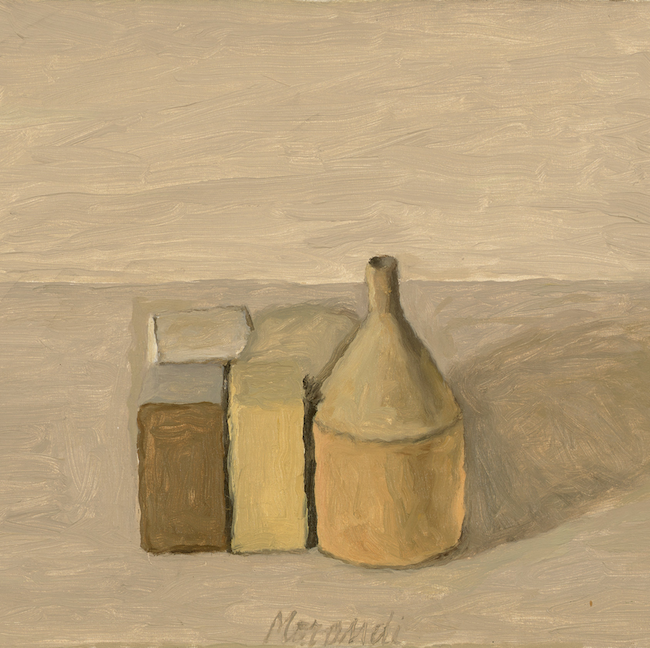Writing for the New York Times, Roberta Smith begins by describing the paintings of Italian Giorgio Morandi as “comfort food” before winding up someplace far more sublime.
Above image: Giorgio Morandi, Natura morta (Still Life), 1954
But when you actually stand before Morandi’s paintings and prints, they provide a much more complicated, invigorating form of sustenance. His exclusive concentration on still life (and sometimes landscape) pushed to the brink of abstraction can bowl you over. So can the searching tenderness with which he illuminates and joins subject, form and content by repeatedly rendering the same few objects in slightly different combinations and arrangements. While reveling in his works’ serene beauty, you’re also examining painting as object, personal expression, visual philosophy and mirror — not just of reality but of existence itself.
Morandi, the potter’s painter, is being exhibited in two shows in New York, the first is at David Zwirner (November 6 — December 19, 2015) and the second has a longer engagement at the Center for Italian Modern Art (October 9, 2015 — June 25, 2016). The Center’s show focuses on rarely-seen works from the 1930s, accompanied by photographs that show many of the vessels he painted. A remark from Smith illustrates how the exhibition will be of special interest to CFile’s readers:
The photographs also show how Morandi regularly altered his objects. He extended the necks of some vases and painted others. He coated the interiors of clear glass vessels with paint and covered blocks of wood with paper. Several of these items migrate from painting to painting in both galleries. If Morandi couldn’t find what he needed, he sometimes had it made. One such object is displayed at the center: a copper can that is like a stage backdrop, with a flat back made of gray metal. Only the front mattered.

Giorgio Morandi, Natura morta, 1938
Zwirner states their show focuses on Morandi’s period of refinement, which, according to Smith, is characterized by the “art of constant adjustment,” a feature which gives his work its paced, mesmiric quality. Zwirner states:
Included in this exhibition are four of the artist’s iconic yellow cloth paintings: executed in 1952, the paintings from this series each depict a group of three to five bottles arranged on a tabletop and clustered around a crumpled yellow cloth. By varying the hue of the central bowl as well as the shapes and configurations of the vessels and cloth, Morandi articulated faint but profound distinctions and affinities of color, shape, and volume. Also included in the exhibition is a pivotal 1956 canvas from a series in which Morandi foregrounded rectangular blocks of rich yellow, salmon, and cream colors, whose geometric forms relate most closely to those of Minimalist sculpture. Several paintings depicting Morandi’s favored subjects—a yellow Persian bottle, a white fluted vase, and a water jug—will also feature in the exhibition. The artist’s serial depiction of these objects, shown variously arranged in irregular configurations and tightly compacted so as to layer, abut, and obfuscate the shapes of adjacent forms, elaborate Morandi’s credo that “Nothing is more abstract than reality.”
Love contemporary ceramic art + design? Let us know in the comments.

Giorgio Morandi, Cactus, 1917

Giorgio Morandi, Roses, 1917

Add your valued opinion to this post.